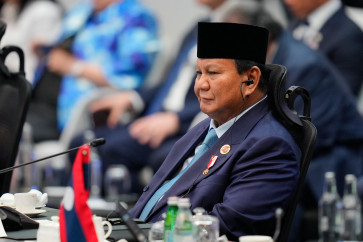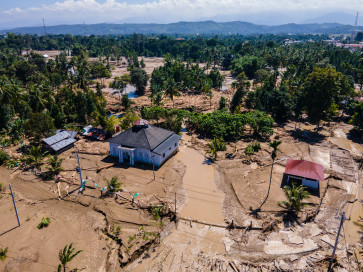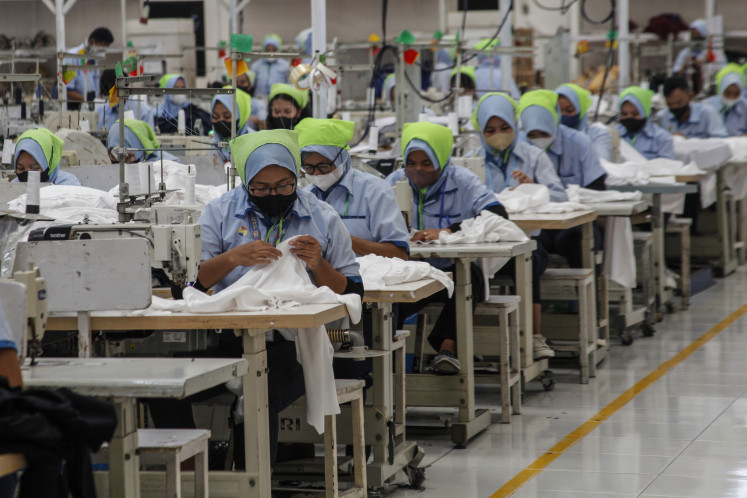Popular Reads
Top Results
Can't find what you're looking for?
View all search resultsPopular Reads
Top Results
Can't find what you're looking for?
View all search resultsThousand Islanders struggle to conserve marine species
Local authorities and fishermen in the Thousand Islands regency have been working hand-in-hand over the last couple of years to harmonize conservation efforts with business interests
Change text size
Gift Premium Articles
to Anyone
L
ocal authorities and fishermen in the Thousand Islands regency have been working hand-in-hand over the last couple of years to harmonize conservation efforts with business interests.
Their efforts have borne significant change, particularly in the way the fishermen make a living while sustaining marine biodiversity.
Before the islands were officially declared one of seven national marine parks in the country in 1995, they faced serious threats to more than 134 species of coral reefs and other endangered marine life, including the hawksbill turtle, the green turtle and the giant abalone.
Thousand Islands National Marine Park head Joko Prihatno says the threats came from destruc-
tive fishing methods using explosives, and the large-scale plunder of living coral.
“Business interests often run counter to efforts to save the environment, and so that’s why we’re trying to find common ground,” Joko says during a visit to Pramuka island, part of the marine park area.
“We aim to improve the fishermen’s welfare and at the same time save the marine resources from destruction.”
He adds the environmental damage is also wreaked by outsiders, particularly companies in the marine life trade.
“We need to create an integrated and self-reliant conservation system that can serve as a benchmark for all stakeholders here,” Joko says.
Managed by the Forestry Ministry, the 107,500-hectare marine park is home to various typed of coral, including Acropora and Porites, and the Turbinaria algae.
Beauty down under: Abalone or Haliotis asinina are seen in an aquarium inside the breeding site in the Thousand island regency. (JP/Desy Nurhayati)
The area also boasts mangrove forests that have been replanted intensively since 2003.
In 2004, the ministry divided the area into four zones to improve conservation efforts.
The core zone of 4,500 hectares hosts the nesting grounds for hawksbill turtles. It also serves as a protection zone for the turtles, coral reefs and mangroves.
The second zone, the 26,200-hectare protection zone, is used for research and education and for limited tourism. Migratory species are also bred in this zone.
The tourism zone of 59,600 hectares is used for marine recreation, while the inhabited zone of 17,121 hectares is designed to accommodate the activities of the fishermen and the entire community on the islands.
Through the conservation efforts, the marine park management is targeting coverage of living coral of 40 percent by 2010.
In cooperation with the NGO Indonesian Coral Reef Foundation (Terangi), the park management has conducted a study on coral reefs in the area every two years since 2003.
The studies show the coverage at the core zone reached 30.39 percent in 2003 and 31.98 percent in 2005, before increasing to 33.44 in 2007.
In the tourism zone, the coverage was 30.67 percent in 2003 and 40.03 percent in 2005. In 2007, however, it decreased to 31.5 percent.
In the inhabited zone, the coverage was 40.63 percent in 2003, down to 31.98 percent in 2005, then up to 33.44 percent in 2007.
The park management is scheduled to hold the 2009 coral coverage study in October, along with Terangi, the fisheries agency, the tourism agency and university researchers, to monitor the coral coverage level and the condition of biodiversity in the marine park.
“By preserving the coral, we also preserve other marine species that make the coral reefs their homes,” Joko says.
“If the coral coverage decreases, the species will lose their homes.”
He adds the park is currently mapping the mangrove and coral ecosystems in and around 15 islets, including Pramuka, Panggang, Karya, Kelapa, Harapan, Kelapa Dua, Kotok, Pantara, Puteri and Sepa.
“The map will be a reference for all stakeholders interested in taking part in our conservation programs,” he says.
Besides increasing coral coverage, the conservation efforts are also expected to raise each fisherman’s monthly income to more than Rp 3 million per month and to create more jobs.
Coral transplantation is one of the main conservation programs carried out by the fishermen. In this program, they work in groups and cooperate with exporters.
There are 26 groups consisting of 120 fishermen, which are supported by 26 companies. However, only 13 of the groups are still active in transplanting and exporting coral reefs, while the rest only fulfill their responsibility to transplant but not to export.
Some non-active companies are focusing on selling dead coral because it’s more profitable, Joko says. A piece of dead coral sells for about Rp 25,000, while live coral is usually sold in bulk, making it less expensive.
Selling transplanted coral helps reduce the looting of coral from the seabed and increase fishermen’s income.
The park management also has a certification method in place to harmonize business interests with conservation programs. This applies to the trade of exotic fish, in which the fishermen also cooperate with exporters.
The certificate is issued by the international Marine Aquarium Council (MAC).
“We submit reports to the MAC every six months,” Joko says.
“Certification is crucial in winning the trust of the international market and raising the fishermen’s welfare, as well as in restoring the level and quality of our exotic marine fish.”
The park management also works together with the Jakarta Husbandry, Fishery and Marine Agency in the certification program.
In addition to trading in exotic fish, the fishermen also breed the fish and receive certification from the MAC to ensure the breeding program meets international standards of environmental safety and management.
“We’re looking to complete the certification by the end of this year,” Joko says.
“We’re currently undergoing an audit by the MAC.”
Despite the intensive efforts to restore the marine ecosystem, the park management still faces serious threats, including destructive fishing using explosives, theft of live coral, and sedimentation caused by waste carried over by the tide from North Jakarta.
Joko points out the conservation efforts have yet to encompass the whole Thousand Islands area.
“The programs have only focused on the marine park, which itself only accounts for 15 percent of the Thousand Islands area,” he says.
“That’s why we also need to expand the coverage.”
Another looming threat comes from the islands’ rapidly booming population, which could trigger land reclamation to establish new residential areas.
Population growth in the islands hovers at 3.5 percent a year, with the population density now 400 people per hectare in Panggang and 350 people per hectare in Harapan and Kelapa.
The Thousand Islands regency administration’s plan to reclaim Pramuka, expanding it from the current 9 hectares to 60 hectares, will also threaten the marine ecosystem, Joko warns.
“We fear the reclamation will destroy the coral reefs, especially if the administration allows the building of resorts,” he says.
“We’re hoping for greater public advocacy to steer the administration’s plans and our ongoing conservation programs in the same direction.”
To prevent coral reef destruction from tourism, the park management has designated open and closed diving spots. Certain diving spots, where the condition of the coral has degraded, are temporarily closed for natural restoration.










